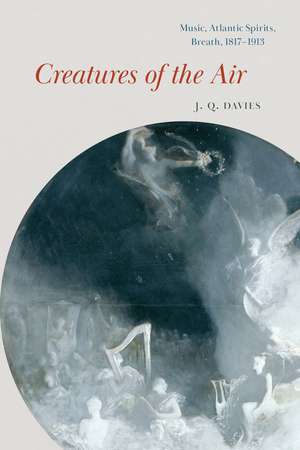Creatures of the Air: Music, Atlantic Spirits, Breath, 1817–1913: New Material Histories of Music
Autor J. Q. Daviesen Limba Engleză Hardback – 11 aug 2023
Often experienced as universal and incorporeal, music seems an innocent art form. The air, the very medium by which music constitutes itself, shares with music a claim to invisibility. In Creatures of the Air, J. Q. Davies interrogates these claims, tracing the history of music’s elemental media system in nineteenth-century Atlantic worlds. He posits that air is a poetic domain, and music is an art of that domain.
From West Central African ngombi harps to the European J. S. Bach revival, music expressed elemental truths in the nineteenth century. Creatures of the Air tells these truths through stories about suffocation and breathing, architecture and environmental design, climate strife, and racial turmoil. Contributing to elemental media studies, the energy humanities, and colonial histories, Davies shows how music, no longer just an innocent luxury, is implicated in the struggle for control over air as a precious natural resource. What emerges is a complex political ecology of the global nineteenth century and beyond.
Preț: 375.11 lei
Nou
Puncte Express: 563
Preț estimativ în valută:
71.78€ • 74.52$ • 59.86£
71.78€ • 74.52$ • 59.86£
Carte disponibilă
Livrare economică 03-17 martie
Livrare express 14-20 februarie pentru 38.95 lei
Preluare comenzi: 021 569.72.76
Specificații
ISBN-13: 9780226826134
ISBN-10: 0226826139
Pagini: 288
Ilustrații: 44 halftones
Dimensiuni: 152 x 229 x 28 mm
Greutate: 0.54 kg
Ediția:First Edition
Editura: University of Chicago Press
Colecția University of Chicago Press
Seria New Material Histories of Music
ISBN-10: 0226826139
Pagini: 288
Ilustrații: 44 halftones
Dimensiuni: 152 x 229 x 28 mm
Greutate: 0.54 kg
Ediția:First Edition
Editura: University of Chicago Press
Colecția University of Chicago Press
Seria New Material Histories of Music
Notă biografică
J. Q. Davies is professor of music at the University of California, Berkeley. With Nicholas Mathew, he is the coeditor of the New Material Histories of Music series at the University of Chicago Press. He is the author of Romantic Anatomies of Performance and coeditor, with Ellen Lockhart, of Sound Knowledge: Music and Science in London, 1789–1851.
Cuprins
List of Illustrations
Introduction
Chapter 1 White “Genius”: Ngango, Gabon Estuary, 1817
Chapter 2 A Falcon under Glass: Paris, France, 1838
Chapter 3 Moral Atmospherics in Elijah: Black Country, Britain, 1846–1860
Chapter 4 Black Musics Control: Santa Maria de Belém do Grão-Pará, Brazil, 1871
Chapter 5 A Spectral Image of Breath: New York, United States, 1901
Chapter 6 Albert Schweitzer’s Equatorial Piano: Lambaréné, Gabon, 1913
Epilogue
Acknowledgments
Notes
Index
Introduction
Chapter 1 White “Genius”: Ngango, Gabon Estuary, 1817
Chapter 2 A Falcon under Glass: Paris, France, 1838
Chapter 3 Moral Atmospherics in Elijah: Black Country, Britain, 1846–1860
Chapter 4 Black Musics Control: Santa Maria de Belém do Grão-Pará, Brazil, 1871
Chapter 5 A Spectral Image of Breath: New York, United States, 1901
Chapter 6 Albert Schweitzer’s Equatorial Piano: Lambaréné, Gabon, 1913
Epilogue
Acknowledgments
Notes
Index
Recenzii
“Erudite and virtuosic, this beautifully written book changes our understanding of the European nineteenth century in significant ways by exploring how cultural reveries about atmosphere, breath, and air were allied to musical aesthetics, performance, and sound making. Davies’s work addresses environments and their impact on humans, the global transmission of cultural artifacts, and colonialism’s legacy. What emerges is no less than a seismic shift in our understanding of Western art music.”
“With Creatures of the Air, Davies offers a sweeping, multicontinent analysis of air as a matrix for nineteenth-century European colonial genealogies of music, which he argues were fundamentally biopolitical and entangled with racial capitalism. ‘Music’—in contrast with earlier European paradigms like aria—emerges in Davies’s account as an artful sounding abstracted from its potentially dangerous source elements and environments. This extractivist impulse, he shows, required intensive management of sound production and built sound environs from Gabon to New York, Amazonia, and industrial Britain. Elegantly written and replete with fascinating case studies, Creatures of the Air makes a major contribution to ecomusicology, nineteenth-century cultural history, and European music studies, and it will undoubtedly be read and assigned for years to come.”
“Creatures of the Air is also a history of things heard, touched, breathed, and felt. Piercing the nineteenth century’s vacuum-packed conception of music, Davies spins each self-contained chapter out of a network of sounding objects, from climate-controlled performance halls and bell jars to possessive spirits and wax cylinders. Linking them all is the airy realm of music, a field of (disavowed) materiality that is alternatively haunting and life-giving.”
"Davies’s voice wields a sophisticated blend of elegy, frustration, and spoof. Indeed, the text excels as an anthology of beautifully narrated “stories, all the way down”. . . . Creatures of the Air is at its best when upholding a historiography that is aware of how it constructs the “materials of the archive itself.” Readers will appreciate the assemblage of a “delicate trail” (to use Bruno Latour’s analogy) within chapters, and sometimes across them. This is a trail that we can traverse from person to person (family, friend, associate, loved and feared stranger), building, boat, instrument, diary, teaching manual, and so much more."
"Davies describes this book as 'an anthology of stories' . . . . Together the stories provide, very roughly, a particular view of 19th-century European music in light of its propagation through the 'Atlantic' world. The thematic driver is air, not air as metaphor or as dumb medium but air as music's reifying element. The perspective, global and environmental, calls into play a vast range of scholarly threads. . . . The book may become a classic, and should sit in every comprehensive music collection."









